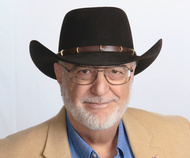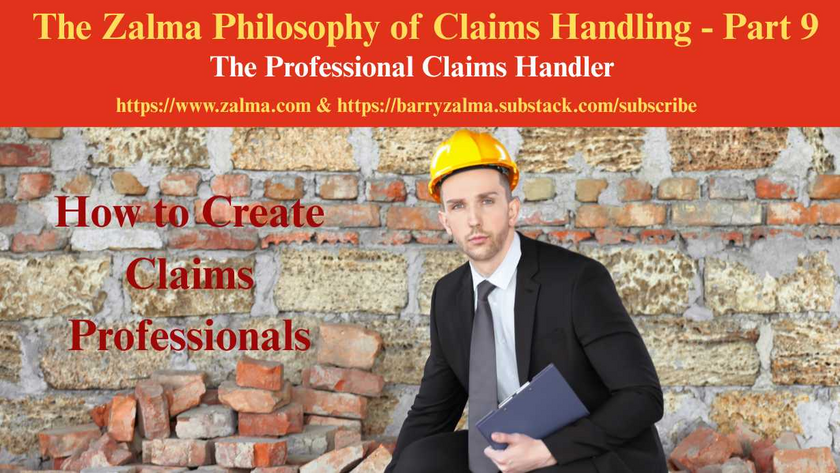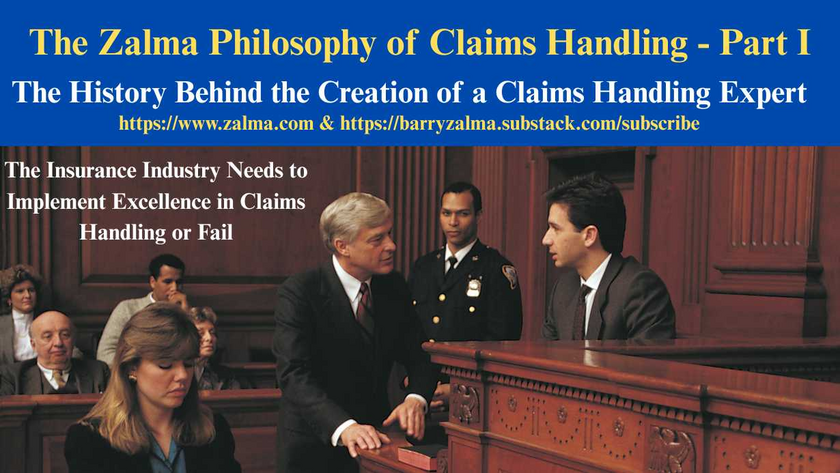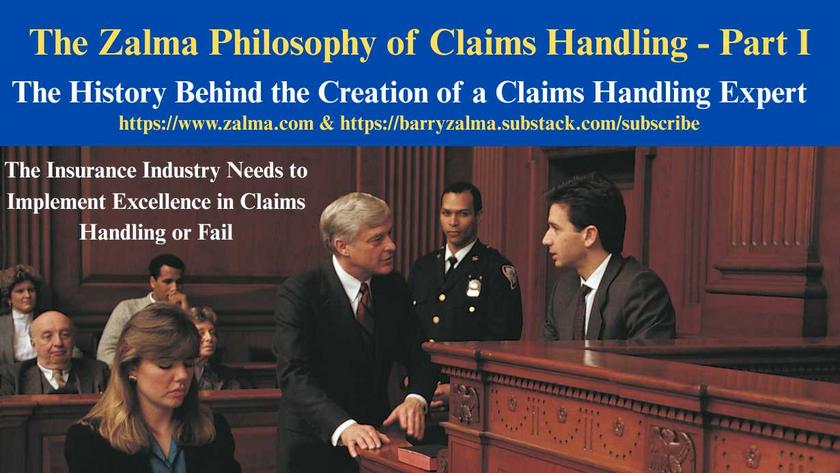
Trade Dress Infringement is Different From Trademark Infringement
Barry Zalma
Read the full post at https://lnkd.in/gk9zRBVW and see the full video at https://lnkd.in/gNKNXPXm and at https://lnkd.in/gCf8zRna and at https://zalma.com/blog plus more than 4350 posts.
In State Farm Fire v. Jason Hines, et al., No. 21-2354, USCA, Third Circuit (October 14, 2022) an insurer was found to have no duty to defend because of a trade mark infringement exclusion.
FACTUAL BACKGROUND
An insurance coverage dispute arose concerning the scope of two commercial liability insurance policies. The policies covered advertising injuries arising out of infringement upon another’s Trade Dress, but they exclude injuries arising out of Trademark infringement.
When the insured was sued for trademark infringement, the insurer initially agreed to defend the insured with reservations. After completing its investigation State Farm sought permission to withdraw from that representation. The insurer sued, seeking a declaratory judgment, and the District Court entered summary judgment in its favor: the policies’ coverage of trade dress infringement claims did not extend to the suit for trademark infringement.
The Insurance Policies
The two commercial insurance policies at issue were issued by State Farm. In 2013, both policies used the same language in providing coverage for “personal and advertising injury.” That coverage included the obligation to defend against suits arising out of infringement “upon another’s copyright, Trade Dress or slogan in your ‘advertisement.'” (emphasis added). But that advertising injury coverage excluded claims “[a]rising out of the infringement of copyright, patent, trademark, trade secret or other intellectual property rights.” (emphasis added). Under both policies, that exclusion did not apply to infringement in an advertisement “of copyright, Trade Dress or slogan.” (emphasis added).
Dedicated Business Systems International (‘DBSI’) purchased those policies from State Farm for itself and its officers when conducting DBSI business.
The Underlying Lawsuit
For a time, DBSI was an authorized reseller of Avaya communications technology. The authorized-reseller arrangement terminated in 2013, but DBSI and one of its officers allegedly continued to access Avaya software license portals afterwards – without Avaya’s authorization. By doing so, they were allegedly able to distribute pirated licenses to customers for a handsome profit, all the while using Avaya’s trade name and marks to falsely represent that the software was “valid and authorized by Avaya.”
Believing that DBSI engaged in a “massive illegal software piracy operation,” Avaya sued DBSI and its officer. Avaya’s eight-count complaint included federal claims for trademark infringement and copyright infringement. In response, State Farm sent a letter to DBSI and the officer to inform them that it had appointed counsel to defend them in the Avaya lawsuit but that letter reserved State Farm’s right to withdraw if it determined that the claims were outside of the policies’ scope.
Consistent with that reservation of rights, State Farm initiated a lawsuit for a judgment declaring that it did not have to defend or indemnify DBSI and its officer in the Avaya lawsuit, moved for summary judgment, and the motion was granted. DBSI appealed.
DISCUSSION
Since neither policy specifically defines the two critical terms – “trade dress” infringement and “trademark” infringement, the Third Circuit determined that as a matter of intellectual property law, the concepts of trademark and trade dress have much in common, with trade dress often treated as a subspecies of trademark. The case did not concern trademark and trade dress in the abstract; it concerned insurance policies that exclude claims for trademark infringement and cover claims for trade dress infringement.
Claims for trademark infringement and trade dress infringement have distinct elements.
First: A claim for trademark infringement has three elements:
1 a valid and legally protectable mark;
2 owned by the plaintiff;
that, when used by the defendant to identify goods or services, is likely to create confusion concerning the origin of the goods or services.
Second: A claim for trade dress infringement requires an articulation of the specific features of the distinct trade dress sought to be protected followed by proof that an infringing design is nonfunctional; distinctive, either inherently or through secondary meaning; and likely to confuse consumers.
For State Farm to have a duty to defend the Avaya lawsuit against DBSI and its officer, Avaya’s operative complaint must potentially state a claim for trade dress infringement. But it does not.
The operative complaint never mentions “trade dress.” Nor does it provide a basis for reasonably inferring such a claim. It does not contain the requisite description of the specific features of a trade dress that it seeks to protect.
Avaya’s complaint lacked allegations necessary for a trade dress claim, and the District Court did not err in applying New Jersey law to conclude that State Farm did not have to defend DBSI and its officer in the Avaya litigation.
The judgment of the District Court was, therefore, affirmed.
No alt text provided for this image
ZALMA OPINION
Infringing a trademark is the type of lawsuit that is often contentious and expensive to defend. Insurers, like State Farm, prefer to avoid such actions and exclude defense or indemnity for trademark infringement. On the other hand, trade dress infringement, putting out a product with a label that looks almost exactly like another’s – a Rolex watch is not a Bolex that looks like a Rolex but is not the same; a Mont Blanc pen is not the same as a Mont Blank pen even if it has a snow cap.
(c) 2022 Barry Zalma & ClaimSchool, Inc.
Barry Zalma, Esq., CFE, now limits his practice to service as an insurance consultant specializing in insurance coverage, insurance claims handling, insurance bad faith and insurance fraud almost equally for insurers and policyholders. He practiced law in California for more than 44 years as an insurance coverage and claims handling lawyer and more than 54 years in the insurance business.
He is available at http://www.zalma.com and [email protected] and receive videos limited to subscribers of Excellence in Claims Handling at locals.com https://zalmaoninsurance.locals.com/subscribe.Subscribe to Excellence in Claims Handling at https://barryzalma.substack.com/welcome.
Now available Barry Zalma’s newest book, The Tort of Bad Faith, and “How to Acquire, Understand, and Make a Successful Claim on a Commercial Property Insurance Policy: Information Needed for Individuals and Insurance Pros to Deal With Commercial Property Insurance” the New Books are now available as a Kindle book here, paperback here and as a hardcover here available at amazon.com.
Write to Mr. Zalma at [email protected]; http://www.zalma.com; http://zalma.com/blog; daily articles are published at
Zalma on Insurance
Insurance, insurance claims, insurance law, and insurance fraud .
By Barry Zalma
Go to the podcast Zalma On Insurance at https://anchor.fm/barry-zalma; Follow Mr. Zalma on Twitter at https://twitter.com/bzalma; Go to Barry Zalma videos at Rumble.com at https://rumble.com/c/c-262921; Go to Barry Zalma on YouTube- https://www.youtube.com/channel/UCysiZklEtxZsSF9DfC0Expg; Go to the Insurance Claims Library – https://zalma.com/blog/insurance-claims-library
Refusal to Provide Workers’ Compensation is Expensive
Post 5240
Read the full article at https://lnkd.in/guC9dnqA, see the video at https://lnkd.in/gVxz-qmk and at https://lnkd.in/gUTAnCZw, and at https://zalma.com/blog plus more than 5200 posts.
In Illinois Department of Insurance, Insurance Compliance Department v.USA Water And Fire Restoration, Inc., And Nicholas Pacella, Individually And As Officer, Nos. 23WC021808, 18INC00228, No. 25IWCC0467, the Illinois Department of Insurance (Petitioner) initiated an investigation after the Injured Workers’ Benefit Fund (IWBF) was added to a pending workers’ compensation claim. The claim alleged a work-related injury during employment with the Respondents who failed to maintain workers’ compensation Insurance.
Company Overview:
USA Water & Fire Restoration, Inc. was incorporated on January 17, 2014, and dissolved on June 14, 2019, for failure to file annual reports and pay franchise taxes. It then operated under assumed names including USA Board Up & Glass Co. and USA Plumbing and Sewer. The business ...
Arsonist Incompetently Moves Pro Se to Avoid Prison
Post 5239
Read the full article at https://lnkd.in/gRX8TfKn, see the video at https://lnkd.in/gY3Jvnqp and at https://lnkd.in/gRCaaf-3, and at https://zalma.com/blog plus more than 5200 posts.
In Christopher A. Barosh v. Morris Houser, et al., Civ. No. 22-0769, United States District Court, E.D. Pennsylvania (November 25, 2025) a convicted arsonist and insurance fraudster moved the USDC acting in Pro se filed Objections to Magistrate Judge Reid’s Recommendation that the US District Judge dismiss his § 2254 Petition to avoid jail.
BACKGROUND
In October 2005, Barosh set fire to his girlfriend’s Philadelphia home — some 25 hours before the cancellation of the property’s insurance policy. Several witnesses saw Barosh leaving the property shortly before the fire erupted. After the fire, Barosh made “two separate admissions of guilt.”
He attempted to pay an acquaintance to provide him with an alibi for the time of the arson. The eyewitnesses, brother, and ...
Conditional Release Allows Supplemental Claims
Post 5238
Read the full article at https://lnkd.in/ge2yNQby, see the video at https://lnkd.in/gcSF9KWj and at https://lnkd.in/gQfJqwiM, and at https://zalma.com/blog plus more than 5200 posts.
A Release Should Totally Resolve Dispute
In Harvey et al. v. Hall, No. A25A1774, Court of Appeals of Georgia, Fourth Division (December 3, 2025) Paul Harvey, an employee of Arthur J. Dovers (d/b/a 3D Mobile Home Services), drove a truck towing a trailer loaded with machinery and equipment. Harvey fell asleep, veered off the road, and crashed into a culvert, causing Lamar Hall serious injuries.
FACTS OF SETTLEMENT
On August 18, 2020, Hall signed a limited liability release under OCGA § 33-24-41.1, releasing Harvey, Dovers, and their insurer (Georgia Farm Bureau Insurance Company) from liability for the accident in exchange for $50,000, “except to the extent other insurance coverage is available which covers the claim.”
Dovers’s general liability insurer (Republic-Vanguard ...
The Professional Claims Handler
Post 5219
Posted on October 31, 2025 by Barry Zalma
An Insurance claims professionals should be a person who:
Can read and understand the insurance policies issued by the insurer.
Understands the promises made by the policy.
Understand their obligation, as an insurer’s claims staff, to fulfill the promises made.
Are competent investigators.
Have empathy and recognize the difference between empathy and sympathy.
Understand medicine relating to traumatic injuries and are sufficiently versed in tort law to deal with lawyers as equals.
Understand how to repair damage to real and personal property and the value of the repairs or the property.
Understand how to negotiate a fair and reasonable settlement with the insured that is fair and reasonable to both the insured and the insurer.
How to Create Claims Professionals
To avoid fraudulent claims, claims of breach of contract, bad faith, punitive damages, unresolved losses, and to make a profit, insurers ...

The History Behind the Creation of a Claims Handling Expert
The Insurance Industry Needs to Implement Excellence in Claims Handling or Fail
Post 5210
This is a change from my normal blog postings. It is my attempt. in more than one post, to explain the need for professional claims representatives who comply with the basic custom and practice of the insurance industry. This statement of my philosophy on claims handling starts with my history as a claims adjuster, insurance defense and coverage lawyer and insurance claims handling expert.
My Training to be an Insurance Claims Adjuster
When I was discharged from the US Army in 1967 I was hired as an insurance adjuster trainee by a professional and well respected insurance company. The insurer took a chance on me because I had been an Army Intelligence Investigator for my three years in the military and could use that training and experience to be a basis to become a professional insurance adjuster.
I was initially sat at a desk reading a text-book on insurance ...

The History Behind the Creation of a Claims Handling Expert
The Insurance Industry Needs to Implement Excellence in Claims Handling or Fail
Post 5210
This is a change from my normal blog postings. It is my attempt. in more than one post, to explain the need for professional claims representatives who comply with the basic custom and practice of the insurance industry. This statement of my philosophy on claims handling starts with my history as a claims adjuster, insurance defense and coverage lawyer and insurance claims handling expert.
My Training to be an Insurance Claims Adjuster
When I was discharged from the US Army in 1967 I was hired as an insurance adjuster trainee by a professional and well respected insurance company. The insurer took a chance on me because I had been an Army Intelligence Investigator for my three years in the military and could use that training and experience to be a basis to become a professional insurance adjuster.
I was initially sat at a desk reading a text-book on insurance ...














